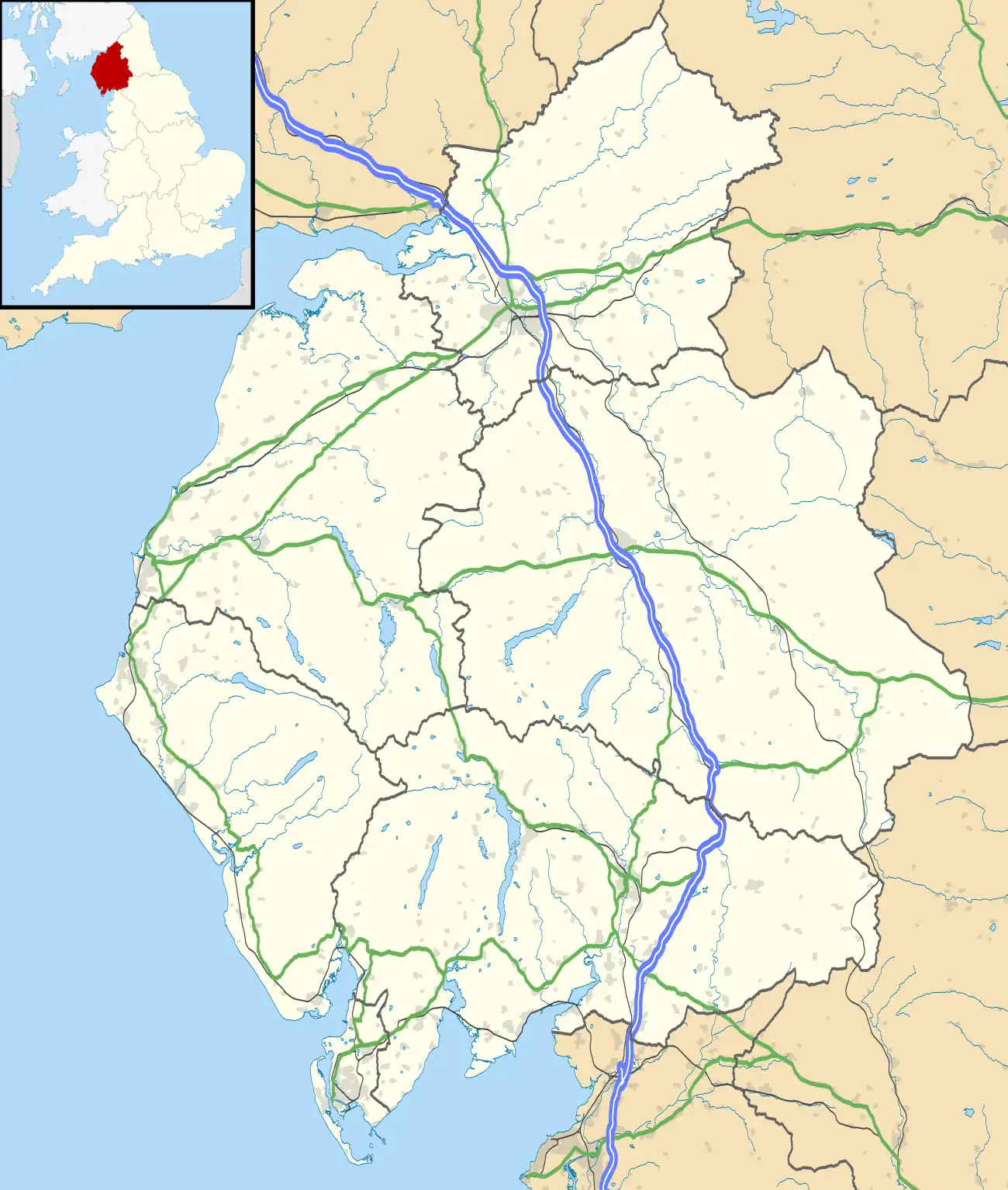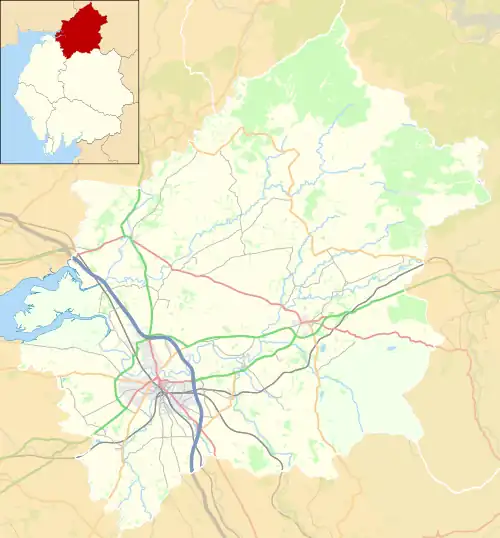RAF Spadeadam
RAF Spadeadam (pronounced "Spade Adam"[2]) (IATA: N/A, ICAO: EGOM) is a Royal Air Force (RAF) station in Cumbria, England, close to the border with Northumberland. It is the home of the 9,000 acre (36 km2) electronic warfare (EW) tactics range, making it the largest (by area) RAF base in the United Kingdom.[3] Its primary use is for EW training to the RAF and NATO allies.[4] The site and course of Hadrian's Wall runs a few miles south of the range.[5]
| RAF Spadeadam | |
|---|---|
| Near Gilsland, Northumberland in England | |
 RAF Spadeadam | |
 RAF Spadeadam Location in Cumbria, England  RAF Spadeadam Location in the City of Carlisle district, Cumbria | |
| Coordinates | 55°01′30″N 002°36′08″W |
| Type | Royal Air Force station |
| Area | 7,820 acres (3,165 ha)[1] |
| Site information | |
| Owner | Ministry of Defence |
| Operator | Royal Air Force |
| Site history | |
| Built | 1955 |
| In use | 1957 – present |
| Garrison information | |
| Current commander | Wing Commander Andrew Tidmarsh BSc (Hons) MA MRes MSc RAF |
Spadeadam
The Spadeadam area was remote and largely uninhabited and known as Spadeadam Waste.[6] The name is possibly a corruption of Cumbric ysbyddaden "hawthorn", or "ysbytybrenin" "king's hostel", and in 1950 the recorded pronunciation was /spɪdɪdəm/.[7] It is mentioned as "Speir Adam"[8] or "Spear Edom" in "Hobie Noble".[9]
History
Cold War

The site was first built in 1955 to be the test centre for the Blue Streak intermediate-range ballistic missile project.[10] The role of Spadeadam in Britain's Cold War nuclear weapons programme was made public in 2004 when tree felling uncovered remains of abandoned excavations for an experimental missile silo. Spadeadam was probably intended to be one of 60 launch sites planned for remote locations.[11]
The Rocket Establishment, as it was called, was divided into five areas: an administration and assembly block, a British Oxygen Company compound for on-site liquid oxygen fuel manufacture, a component test area, the engine test area and the static firing stands.[12] The engine test area at Prior Lancy Rigg consisted of four concrete stands into which the engines could be mounted for test firing.[13] Two rocket-firing stands themselves stood at Greymare Hills and were large enough to accommodate a full Blue Streak missile.[14]
The RAF took the site over in 1976 and it became Europe's first electronic warfare tactics range in 1977.[15]
Post-Cold War
The site continues to be used in training the Royal Air Force and NATO allied aircrew in electronic warfare. It also hosts other exercising forces such as JFACTSU forward air controller training delivered from RAF Leeming in North Yorkshire. Close air support (CAS) training is carried out too. Since 2006, this has been the only mainland UK location where aircrews can drop practice bombs.[16]
DNV (previously Advantica) uses the site for industrial hazard testing including fire and the destruction of pipelines. The remoteness of the area is key to their operations.[17]
In July 2021, RAF Spadeadam was used to conduct drone swarm trials; a first for the British Armed Forces.[18]
Landscape
The outlying moorland landscape of the site is of increasing importance for its visual quality and for nature conservation. The area includes a pristine peat bog, populations of all three species of British newt and forestry habitat suitable for endangered red squirrels.[19] Otters have been noted along the watercourses and still ponds that are dotted across the vast training area.[20] Trees that were planted on the site after the First World War were felled in 2008 to 2009 to allow the peat bogs to return. Despite concerns about trees being carbon sinks, the rarity of the peat habitat meant the Forestry Commission decided to fell 145,000 trees.[21][22]
Freedoms
RAF Spadeadam has received the Freedom of several locations throughout its history; these include:
References
- "Estate Baseline 2009" (PDF). 3 July 2009. p. 8. Retrieved 2 October 2016.
- Perry, Charles (26 April 1998). "Why Nigel Can't Spell". Los Angeles Times. Retrieved 5 November 2019.; Lloyd, Chris (14 December 2017). "Cold spell means long johns are hot stuff". The Northern Echo. Retrieved 5 November 2019.
- Jennings, Gareth (8 November 2018). "RAF reforms 11 Group to counter new and evolving threats". janes.com. Retrieved 26 November 2018.
- UK Defence Statistics 2004. London: Ministry of Defence. 2004. p. 119. ISBN 0-11-773020-3.
- "MoD Heritage Report 2011-2013" (PDF). Ministry of Defence. p. 8. Retrieved 6 July 2016.
- "MoD Heritage Report 2011-2013" (PDF). Ministry of Defence. p. 6. Retrieved 6 July 2016.
- Armstrong, A. M.; Mawer, A.; Stenton, F. M.; Dickins, Bruce (1950). The Place-names of Cumberland, Part 1: Eskdale, Cumberland and Leath Wards. English Place-Name society. Vol. 20. Cambridge: Cambridge University Press. pp. 96–97.
- Reed, James (2014). Sir Walter Scott: Landscape and Locality. A&C Black. p. 27. ISBN 9781472514110. Retrieved 5 November 2019.
- Quiller-Couch, Arthur (1910). "139. Hobbie Noble". The Oxford Book of Ballads. Retrieved 5 November 2019.
- "History". Royal Air Force.
- Long, David (2015). Lost Britain: An A-Z of Forgotten Landmarks and Lost Traditions. Michael O'Mara. ISBN 978-1782434399.
- Historic England. "RAF Spadeadam: Blue Streak Rocket (1413245)". National Heritage List for England. Retrieved 5 July 2016.
- Historic England. "RAF Spadeadam: Priorlancy Rigg, Engine Test Area (1413098)". National Heritage List for England. Retrieved 25 November 2021.
- Historic England. "RAF Spadeadam Greymare Hill Missile Test Area (1580748)". Research records (formerly PastScape). Retrieved 5 July 2016.
- "Spadeadam". Forgotten Airfields. Retrieved 25 November 2021.
- "Close Air Support". Royal Air Force. Retrieved 5 July 2016.
- "Explosives testing centre to open at Spadeadam". News and Star. 30 June 2016. Retrieved 5 July 2016.
- Mitchell, Ben (17 July 2021). "Commandos operate drone swarms in UK military first". Evening Standard. Retrieved 23 August 2021.
- "Efforts to protect red squirrels". BBC News. 9 December 2007. Retrieved 5 July 2016.
- "Cumbria - RAF Spadeadam". Sanctuary. No. 37. Ministry of Defence. 2008. p. 68. ISSN 0959-4132.
- "Open Country". BBC Radio 4. BBC. Retrieved 5 July 2016.
- "RAF bombers halted by peat bogs". BBC News. 15 April 2008. Retrieved 5 July 2016.
- "Brampton Parish Council - Home". www.bramptonparishcouncil.co.uk.
- "RAF to receive special honour in Brampton".
- "RAF Spadeadam to receive Freedom of the City of Carlisle in celebration of RAF100". cumbriacrack.com. 25 May 2018.